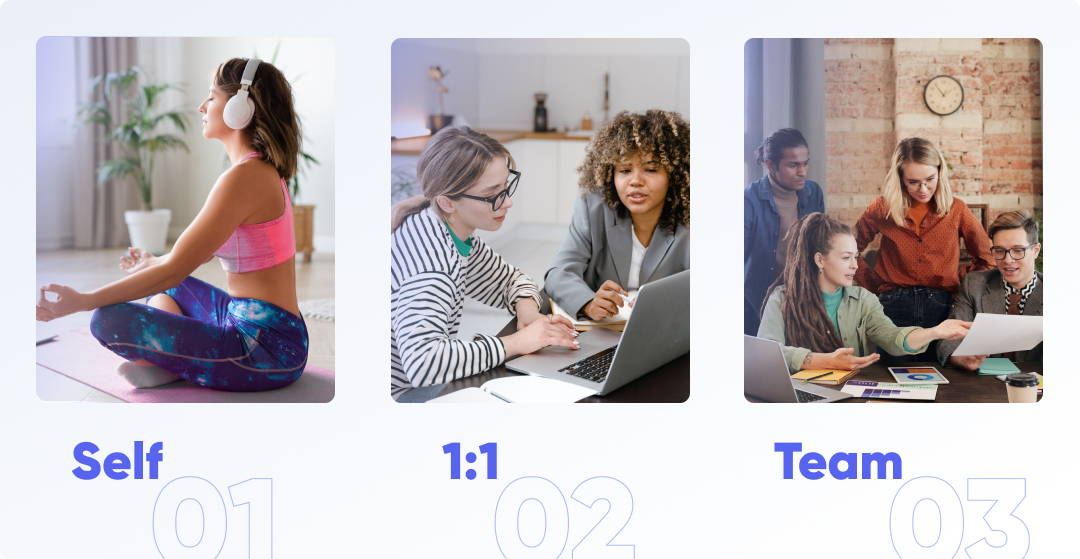With the rise of remote work across the globe, many companies are struggling to implement best practices in order to maintain a sense of community and encourage employee engagement. Teams are now geographically dispersed and separated by screens rather than office walls. Managers are relying on video chats, instant messages, and other forms of virtual communication in place of in-person meetings to connect with their teams.
While these changes alone may not seem too impactful, teams are facing the additional challenge of re-learning how to work with each other without the convenience of in-person office interaction.
To combat this, company leaders are implementing mindfulness training and tactics in order to best support their employees.
Let’s take a closer look at how companies and teams can work together to improve collaboration and communication by implementing mindfulness in a remote environment.
Mindful vs. “Mind-Full”
Mindfulness is the practice of being fully present in the moment. It’s a quality that every human being already possesses, but it needs to be nurtured and learned. This practice is incredibly valuable in the workplace because it increases levels of self-care and resilience, capacity for collaboration, and the ability to lead in complex conditions for leaders and employees alike.
Consider this: is your team operating in a mindful, or a “mind-full” state?

There is a significant difference between the two.
When in a "mind-full" state, some employees might find themselves stressed and overwhelmed. Some feel an urgent need to multitask just to keep up with their lengthy to-do list, while others might have difficulty collaborating with each other due to a cluttered mind. This “mind-full” state enforces the need to constantly focus on the future and become burdened with the anxiety of upcoming assignments.
Mindfulness, on the other hand, allows your employees to maintain presence in the moment and tackle their daily workload—one task at a time. Studies show that mindfulness helps reduce stress and enhance performance, while a “mind-full” state adds pressure and reduces productivity.
In a world where busyness is praised and deemed high-yielding, it’s important to remember that staying busy doesn’t necessarily produce optimal results. Practicing mindfulness as a team and taking the time to connect on a deeper level will strengthen employee relationships and build the foundation for a healthy and collaborative work environment.
Mindful Communication And Collaboration
Mindfulness practices are one of the most accessible methods of incorporating wellness into your lifestyle. It requires no equipment, can take just a few minutes, increases emotional awareness, aids in critical thinking, and reduces lingering stress and anxiety.
In as little as five minutes, your employees can partake in a mindfulness session to help regulate and restore their mental, emotional, and physical space.
Enhanced communication is the key to elevating remote team collaboration. While communication platforms, such as Slack and email, are extremely effective for async communication, it’s important to have a balance between unsynchronized and real-time connections. As a leader, make it a point to normalize video meetings among your team and encourage those professional relationships.
For example, if your employee has an extensive list of questions for a coworker, suggest that they send a message in Slack asking the co-worker if they are available for a 15-minute conversation. Then, have the team members hop on a Zoom call and engage with each other in real-time to resolve the tasks. Before diving into the work, encourage the coworkers to start the meeting by setting a mindful intention for it using the Wellness Coach Slack App.
Not only does this interaction offer valuable face-to-face connection, but it also helps to break down any feelings of isolation and other communication barriers that are common for employees in a remote work environment.
3 Ways To Practicing Mindfulness As A Remote Team

It’s not difficult to start a mindfulness practice but it does require intention and consistency.
As a remote team, it can feel like you’re on a stranded island at times. An individual and collective mindfulness practice can help your team feel more connected to themselves and each other on a daily and weekly basis. Here are a few ways to get started:
1) Connect With Yourself
Before diving into caring for others, it’s always important to check in with yourself first. Encourage your team to take a moment to themselves every single day to simply close their eyes and recognize their thoughts and emotions. That goes for you as well if you’re a manager or leader!
Doing so will clear their mind of immediate stress and overwhelm, and also pave a path of clarity to tackle the workday ahead. This practice can be done at any time, but starting the day with a foundational mindfulness session will do wonders to center and align your team on an individual level.
Our CEO, D Sharma, explains how his mindfulness routine has transformed who he is as a leader in this interview with Authority Magazine:
“Awareness meditations have had an incredible impact on who I am as a leader, being more mindful of my decision-making and building better relationships within my company and really with just about everyone in my life. I also take in the world around me more, I breathe in sunsets on my morning runs on the beach, I enjoy my backyard garden and the delicious food it provides us, and I feel like I’m just living more.”
2) Connect 1:1
It’s time to take the standard 1:1 meetings to the next level. Encourage your employees to participate in respectful conversations by asking personal questions during your next 1:1 touch-base. Mindfulness plays a key role when it comes to individual meetings. Most people wait for their chance to speak without truly listening to what the other person has to say, which is why it’s important to engage in active listening in order to truly connect with each other.
Taking the time to provide space for others to open up about their thoughts will help you as a manager to understand your employees’ unique skill sets, interests, and personality types. As a result, you will be able to encourage open communication, strengthen connections, and engage more effectively with your team.
3) Connect As A Team
Group mindfulness is an incredibly powerful tool, especially in a remote workplace. It offers support, connection, and knowledge that is often missing outside of a team setting. Engaging in this practice as a team greatly helps to strengthen and build interpersonal relationships, which is vital for employees who work together on a daily basis.
Together, team members can feel unified on the goals that they are aiming to achieve. Additionally, practicing as a team creates a sense of belonging for each individual, which in turn builds a strong dynamic even in a remote work environment. A meditation session at the start of meetings or participating in a mindfulness team challenge on the Wellness Coach app are both great ways to connect together as a team.
How To Implement A Team Mindfulness Practice
Just like anything else, remote work is paired with a handful of challenges, from social isolation to communication barriers. A team mindfulness session is a great way to combat these challenges and share personal experiences, feedback, and support among team members.
The primary reason for implementing a team mindfulness practice in the workplace is to provide your employees with stress relief, enhanced communication skills, and overall wellness.
A digital wellness program such as Wellness Coach makes it easier than ever to incorporate a mindfulness initiative into your remote environment. The Wellness Coach Slack App integration allows users to participate in wellness sessions directly within the communication platform. As more teams begin to incorporate Slack into their work processes, the ability to seamlessly connect to a wellness platform with a range of content and resources makes it simple and accessible for everyone to prioritize and practice team well-being.
.png)

.svg) Share
Share.svg) Tweet
Tweet.svg) Post
Post.svg) Mail
Mail